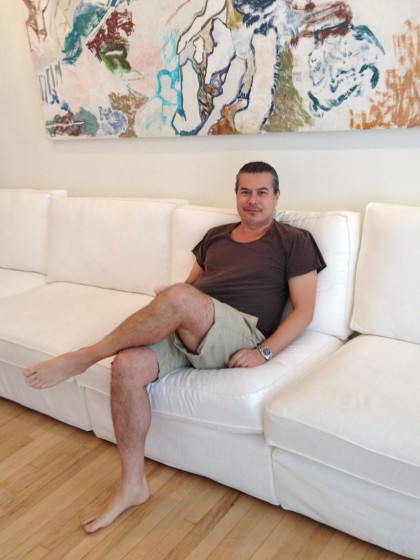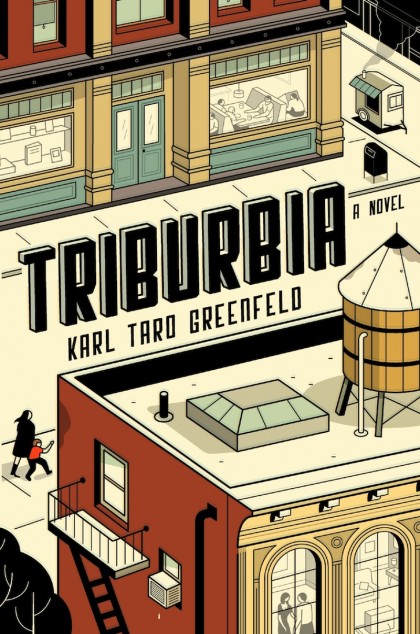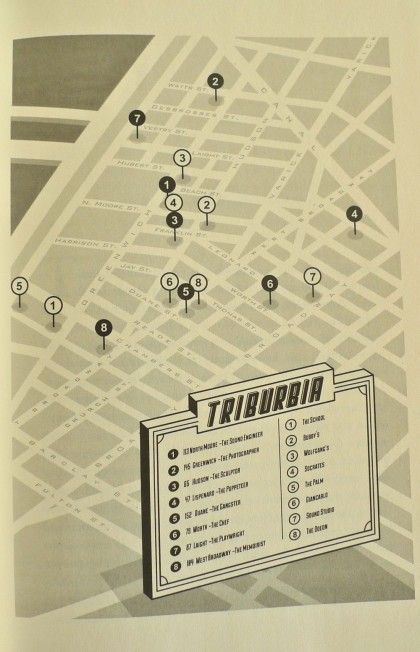Categories
Left column house ads
Coffee With “Triburbia” Author Karl Taro Greenfeld
July 26, 2012 Arts & Culture, People
 “The concerns and values of these people and this class turn out to be identical to suburbia,” says Karl Taro Greenfeld about the characters in his first novel, Triburbia. “They’re worried about schools, a possible molester, real-estate values. They’re in love with their neighbor’s wife.”
“The concerns and values of these people and this class turn out to be identical to suburbia,” says Karl Taro Greenfeld about the characters in his first novel, Triburbia. “They’re worried about schools, a possible molester, real-estate values. They’re in love with their neighbor’s wife.”
 A collection of interconnected stories, Triburbia comes out Tuesday with some heat—including starred reviews in Publishers Weekly and Booklist (“Greenfeld brilliantly illuminates the pecking order and power plays behind the smug façade of this fashionable urban fortress”). And the Observer just posted a profile of Greenfeld (which covers his background more than this will).
A collection of interconnected stories, Triburbia comes out Tuesday with some heat—including starred reviews in Publishers Weekly and Booklist (“Greenfeld brilliantly illuminates the pecking order and power plays behind the smug façade of this fashionable urban fortress”). And the Observer just posted a profile of Greenfeld (which covers his background more than this will).
We’re having coffee in the floor-through apartment on Warren where Greenfeld lives with his wife, Silka, and their daughters, Esmee (13) and Lola (10). “We actually bought it from a puppeteer!” he says. One of the characters in Triburbia is a puppeteer who represents a last remnant of Tribeca’s artist culture as the neighborhood completes its shift from bohemian to bourgeois-bohemian to full-on bourgeois. “There was a time when people moving here had a certain sense of themselves—they might have been bourgeois, but they didn’t see themselves living on the Upper East Side or in Scarsdale or Bedford.” In other words, first came the artists, then the people who liked living among the artists, and now, well…. “At this point, I don’t think there are any artists left.”
There are still some, I say—for whatever reason, the one who comes to mind is Laurie Simmons, now better known as Lena Dunham’s mother. It turns out that Dunham used to babysit the Greenfelds’ daughters, although her ambition didn’t extend to doing the dishes after preparing the kids’ food.
The Greenfelds have lived in Tribeca since 2003, but Triburbia was actually written in L.A., where they moved at the end of 2009 (they moved back around six months ago). “As a writer, you want to write about the world you know. This society felt very rich to me.” The pun didn’t seem intentional. “I wrote one story, ‘Noisemaker,’ that was published in Paris Review. It read to me like a New York magazine story, like ‘Tribal Rites of the New Saturday Night’ [the article that led to Saturday Night Fever]—a viable subject for pop fiction. That’s where the brand of Tribeca comes into play. For better or for worse, Tribeca is a national brand at this point, a cultural nameplate like Malibu or Martha’s Vineyard. I realized that I can do this inside-Tribeca thing. My idea was something like Winesburg, Ohio or Dubliners—not that I’m anywhere as gifted as Anderson or Joyce! But that if you follow the characters, this place emerges.”
While Greenfeld was imagining a novel of interconnected stories, his editor at HarperCollins, wanted one big narrative arc. “The molester in the book was never supposed to be real,” says Greenfeld. “It represents what these people have become. I tried making him real, but it didn’t feel natural.” (And it probably made the book read like Little Children, I interject.) While plugging away, Greenfeld kept working on his stories. What happened next is a classic example of contemporary publishing. “A Visit to the Goon Squad came out, followed by The Imperfectionists”—both are novels with diffuse plots—“and suddenly my plan was a good plan.”
Greenfeld says the theme of Tribeca becoming Triburbia came late to the book, that it was retrofitted. The self-lacerating part in the first chapter was added toward the end. (It’s an electric piece of writing, especially if you live here. It’s not long; go read it and come back when you’re done.) The wealth of Tribeca was never the main point: “You’re interested in people you’re creating, and you’re only adding the world they’re in as you need it. For 90% of what the characters are doing, you don’t need a socioeconomic background.” Greenfeld is sensitive to the idea that, as some people have said, Triburbia is about the 1%. “Almost all of the characters are thinking about money. They’re not so rich.”
As I read Triburbia, I wondered whether more people around here are stoned than I thought. Greenfeld isn’t sure there’s that much pot-smoking in the book, but he agrees that “a fair number of the parents” in these parts regularly indulge. (“It kind of goes along with the glass of wine.”) The amount of sex in Triburbia might also surprise the residents of a community predominantly made up of married couples. “There’s definitely more sex going on in the book than I’ve seen in Tribeca. To have that titillating thing you have to have people screwing each other.”
The Tribeca of Triburbia also struck me as the land of the midlife crisis. Does Greenfeld see the neighborhood headed that direction? Not really, although he points out that the average adult age in the neighborhood is high for New York City. (My theory is that the Pied Piper led all the twentysomethings across the river.) He does expand on the idea of the book being about relationships, and particularly relationships under stress. “I think the book gets at the dishonesty in long relationships really effectively. In every relationship, there are a lot of weird tensions that are never discussed, never admitted. The lies you agree upon; the things you never mention. That was my goal: to write a book that was fun to read but also shed a stark, harsh light on the real landscapes of marriages.”
Not his own, however, even though Greenfeld is half-Japanese with an office at Broadway and White and one of his characters is a half-Chinese sound engineer with a studio on Broadway. “He’s financially much better off than me. I didn’t have the foresight to buy a 4,000-square-foot space.” None of the characters are based on real people, even if there are glimmers of public narratives. “The memoirist is similar to James Frey but every detail is made up. And there are really good anecdotes that I didn’t use—paternity cases and so forth. It just didn’t occur to me.”
It’s a question he’ll be asked again and again, in good part because the genesis of the book was a group of dads who hung out at City Hall (when it served breakfast), Gee Whiz, and Socrates (a diner where Tamarind Tribeca is now) after dropping their kids off at P.S. 234. “There were 12 or 14 guys. There’s something liberating about bullshitting for a while before you start your day.” Other dads in the group also saw the potential in the idea—David Bar Katz wrote a play, “Philip Roth in Khartoum,” about it, and others tried to develop a sitcom (which I don’t think is “Guys With Kids”).
I ask whether he’s concerned about his neighbors taking offense—the book is fictional, but people might recognize themselves in the characters or think he spilled secrets. “There are people in the book who do things that people in real life do. There are sculptors and chefs who live in Tribeca. Inevitably, I’ve used those types. But it’s 100% made up.” I suppose the question is also about how they’ll feel about the mirror that Greenfeld has help to their faces. “I don’t think it’s an unflattering reflection of Tribeca. But then I’ve been told I have a less generous view of humanity than most. But then I’m trying to tell stories, not sell real estate. My point was that Tribeca, for whatever pretensions and airs and self-satisfactions it takes on, is ultimately as flawed—or as pristine—as any other community. That’s no revelation.”
We chat more about restaurants—the ones we like (he recommends Taco House on Church), the ones we can’t believe are still in business—and about Triburbia‘s U.K. cover, a photo of a child sitting on a very Brooklyn-looking stoop. I compliment the U.S. cover, but Greenfeld says it’s missing something: “See this roof? If this were really Tribeca, it would be full of air-conditioning compressors.”
Meet Karl Taro Greenfeld for yourself at Barnes & Noble Tribeca on Sept. 5.
2 Comments
Subscribe
Subscribe to the TC Newsletter














I hope he isn’t taking credit for the name Triburbia, which was coined within the last decade as the neighborhood filled with large apartments and young families. It was NOT meant as a compliment.
Lots of people notice how like suburbia TriBeCa had become – why not acknowledge that? if he’s lived here since 2003, he should know.
I hope he doesn’t get credit for coining the phrase – I had to go top age 9 of Google results to find a reference. http://therealdeal.com/blog/2006/06/12/welcome-to-triburbia-formerly-tribeca/
Great review Erik. It makes me want to read (and more importantly, buy) the book without feeling like I’ve been sold.